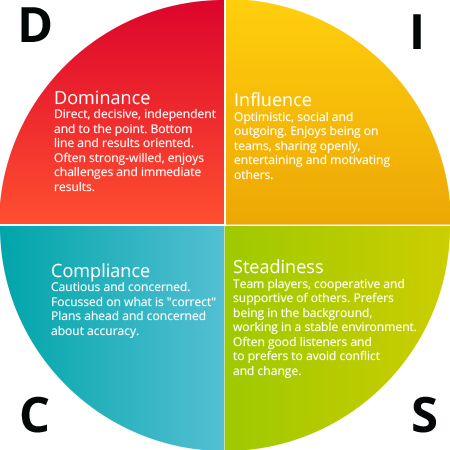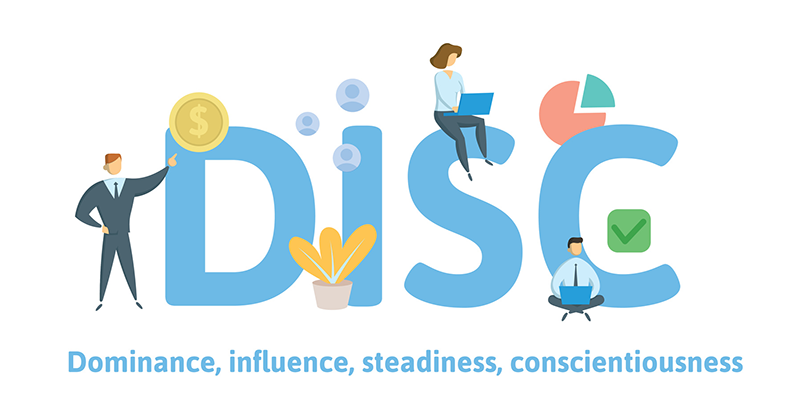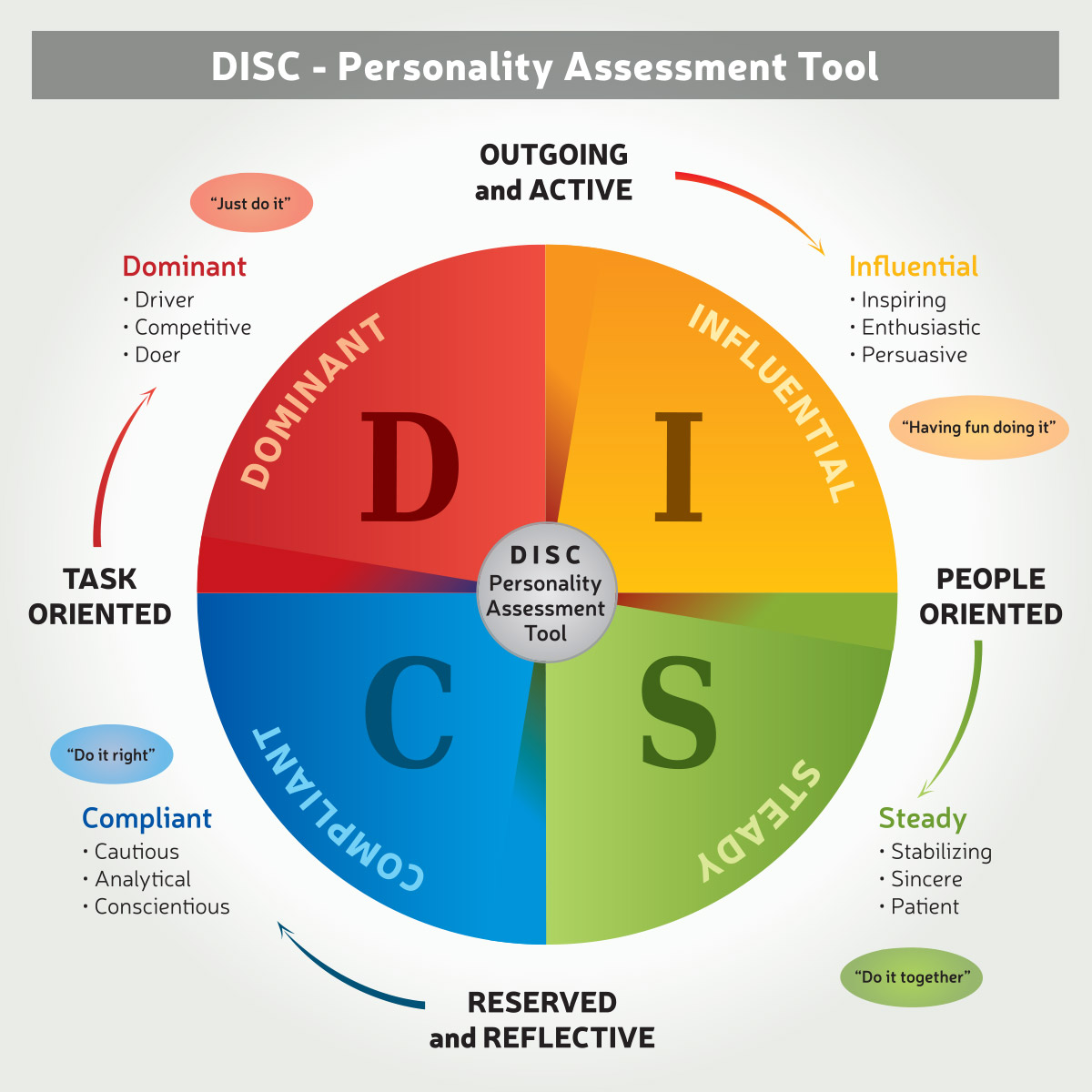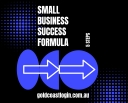What Communication Style Do You Use?

- Aug 12, 2019 modified: Jan, 24 2025
What Communication Style Do You Use?
Communication is about exchanging information and ideas with others. We each have unique ways of communicating with one another. When we understand the differences in our communication styles, we can apply this knowledge to relate better to family members, peers, friends, neighbours, strangers, work colleagues and customers, in fact, in all our personal and interpersonal relationships.
We need to consider using all the tools available to us to improve how we interact with others. One model we can apply to determine the personal communication styles being used in various situations is DISC.

What is DISC?
DISC stands for Dominance, Influence, Steadiness and Conscientious.
The 'Conscientious' communication profile has also been described in some DISC models as 'Compliance' or 'Correctness'.
The following chart may assist us in potentially spotting the characteristic profile we prefer most and the one that may be preferred by the person with whom we are attempting to communicate.
"By identifying the communication / personality style of the person in question, we can contextualise our communication in the most effective way."

Who created DISC?
Dr. William Moulton Marston was a lawyer and physiological psychologist. He invented the first functional lie-detector polygraph, authored self-help books, created the Wonder Woman comic and conceived the DISC model for the analysis of emotions and behaviour in 'normal' people.

Marston published his theory of DISC in his book Emotions of Normal People in 1928. While Marston did not create an assessment tool for his model, others have since created DISC assessments instruments offering a range of DISC tests and tools for the marketplace.
Why use DISC?
If we identify our own and others' preferred DISC communication styles, we potentially possess an effective tool to better interact with them.
We each have our own preferred DISC style. There's a good chance your DISC style will not be the same as the others with whom you interact. And it is useful to identify the DISC style of another so that we know how that person prefers to interact.
"Finally, we modify our own DISC style to communicate more successfully. When we make these adjustments to our DISC style then we can better engage others. They will be more interested in what we have to say and we will most likely have a better outcome."
Where can I find DISC?
A simple "DISC" web search will lead to a number of companies and providers of models and assessment tools using DISC. Some of these tools are free and others can purchased.
Wiley claim that the DiSC assessment tools they publish are fully researched and validated and can be identified by the trademarked lowercase 'i' in DiSC®
"The DiSC profile, published by Wiley, is a non-judgmental tool used for discussion of people's behavioural differences. If you participate in a DiSC program, you'll be asked to complete a series of questions that produce a detailed report about your personality and behaviour. You'll also receive tips related to working with people of other styles.
The DiSC® model provides a common language that people can use to better understand themselves and to adapt their behaviours with others - within a work team, a sales relationship, a leadership position, or other relationships."
(from https://www.discprofile.com/what-is-disc/overview/)

How does DISC assist in the Workplace?
DISC profiles help you and your team to:
- Increase your self-knowledge: how you respond to conflict, what motivates you, what causes you stress, and how you solve problems
- Improve working relationships by recognizing the communication needs of team members
- Facilitate better teamwork and teach productive conflict
- Develop stronger sales skills by identifying and responding to customer styles
- Manage more effectively by understanding the dispositions and priorities of employees and team members
DISC assessments may aid in maximizing productivity and talent management through better employee selection processes, management development, leadership identification, employee retention and job engagement. (from Wiley, 2019)
"DISC has been around for almost a century, is used by almost three-fourths of Fortune 500 companies, and is utilized by all branches of the U.S. military. It’s arguably the most widely used assessment globally when it comes to hiring, recruiting, and team-building."
What is involved in a DISC Assessment?
Generally, DISC assessments ask people to respond to a series of words, descriptions or phrases.

(Wiley, 2019)
DISC is not asking you to change who you are but encouraging you to consider making brief adjustments during the key moments in your interactions with others. In practice, this may be as simple as slowing down, talking more, listening longer or staying focused on the results. However, the outcome(s) may benefit both sides and potentially maximize the exchange of ideas and information. (adapted from http://blog.extendeddisc.org/disc-communication-styles)
Applying DISC - a practical example
RLM Distributing is a Queensland owned and operated family company, supplying tyre and wheel servicing products, tools and technical advice throughout Australia.

A significant client for RLM is the Mining Industry.
A demanding Mining Boss phones RLM to speak about the costs and logistics of supplying major wheel and tyre products and tools for the mining company's heavy transport and equipment at a new mine site. This could be a substantial sale for RLM if handled well by its senior sales staff.
The Mining Boss communicates in the DISC style known as 'Dominance'. They are 'direct, decisive and to the point.' Other descriptions of 'D' communicators include:
- likes to talk and expects others to listen
- expresses own opinions as fact
- often interrupts others
- may be blunt
- a focus on tasks and outcomes
The RLM staff member may begin their interaction with the Mining Boss using elements of the 'Steadiness' communicator. They are 'a good listener, avoid conflict and are cooperative and supportive' of the Mining Boss. 'S' communicators also prefer:
- one on one communications
- to answer only when asked
- to speak calmly and amiably
- to create trust during the interaction
- to explain things calmly and thoroughly
As more details emerge from the Mining Boss regarding the services, products and tools they require, the RLM staff member may move to being a 'Compliance' or 'Conscientious' communicator. They will want 'detailed, fact-based information to ensure they make the correct decisions'. 'C' communicators may also:
- be cautious and concerned
- be extremely diplomatic
- provide details in writing
- not readily express disagreeing views
The final interaction with the 'demanding' Mining Boss may see the RLM staff member shift to elements of the 'Dominance' communication style by 'focusing on tasks and results and offering to move quickly' to achieve them.
The RLM representative, being an expert in their field, may even stand 'toe to toe' with the Mining Boss, informing them of the most suitable products and services for their needs. In speaking the 'same language' as the Mining boss, the RLM staff member may win the respect of and trust from the Boss who feels 'we understand one another and we are both working towards the same outcome'.
RLM gets their sales and the Mining Boss gets a satisfactory result at their mine site.
How can I practice identifying DISC profiles?
An entertaining way to practice identifying DISC communication profiles is to examine politicians, celebrities and Film-TV actors and characters.
For instance, 'D' style personalities may include the Australian ex-politician Tony Abbott or the Americans, Donald Trump and Hilary Clinton.
American TV host Ellen DeGeneres, Australian comedian Peter Helliar and Prince Harry are examples of 'I' style communicators who are active and people orientated, talkative, sociable and optimistic.
The trustworthy and amiable 'S' style communicators might consist of the likes of the revered Australian cookery expert, the late-Martha Graham, American actor, Tom Hanks and Australian actor, Hugh Jackman with their focus on building relationships.
'C' style communicators who are task orientated and reserved include the character Sheldon from 'Big Bang Theory', Hermione from 'Harry Potter' and Oscar winning Australian actor, Cate Blanchett. 'C' communicators can also be self-critical because of the high standards they set for themselves in their work and personal lives.
(adapted from https://blog.extendeddisc.org/4-steps-effective-communication)
The Final Step
Take a DISC assessment or simply do some self-analysis to establish which DISC communication style you use or best describes your communication profile. And then during work, family and recreational activities, try implementing elements of the other DISC communication styles to experience and reflect on the results.
We are never too old to learn something new about ourselves or to try something new such as a DISC assessment, especially if we want to be more effective communicators in all walks of our lives.
Researched, Compiled, Composed and Written by Dr Steven Gration. August 2019
Search News Articles...
Recent Articles

Most AI Websites Fail to Rank
- Nov 18 2025
- /
- 235

Sitemap.xml Best Practices
- Oct 14 2025
- /
- 708

Fake Reviews on Google My Business
- Oct 07 2025
- /
- 448

Sending Emails from Code
- Sep 17 2025
- /
- 549

US Tariff Shifts Undermining eCommerce
- Sep 05 2025
- /
- 676

Small Business Success Formula
- Aug 23 2025
- /
- 522

Do Strong CTAs Help or Hurt Your Website?
- Jul 31 2025
- /
- 716

AI Crawlers vs Search Crawlers
- Jul 04 2025
- /
- 880

AI vs. Human Writing - How to detect Ai
- Jun 26 2025
- /
- 1287

Optimising for Brand SEO
- May 12 2025
- /
- 920
View All News Articles
Categories
A Gold Coast SEO and Web Developer